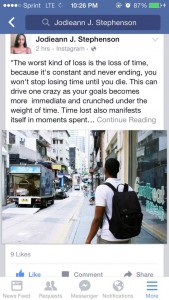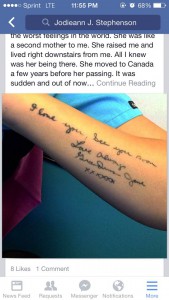In the week of 11/29 after returning from a relaxing break, I returned feeling very excited. During the evening of 11/30 I worked on my second progress presentation. In the second progress report, I wrote candidly about my struggles with having a clear understanding of my project and the end results. I wrote about the ways in which the project made me more disciplined. There were certain elements of the project that was to have been completed however due to timing it was not completed. Also on 11/30 I posted my first image rendition of Humans of New York photo. I interviewed a male friend of mine who is twenty-three years old. He was super excited to share his thoughts on loss. Earlier in the day, after my internship, I met him in China Town, New York where he interns. I took a photo of him from the back because he did not want to show his face. He did not feel comfortable with his face in the photo which is understandable. I took the photo and asked him to send me his quote via text on loss.
The quote: #1 The Loss of Time

“The worst kind of loss is the loss of time, because it’s constant and never ending, you won’t stop losing time until you die. This can drive one crazy as your goals becomes more immediate and crunched under the weight of time. Time lost also manifests itself in moments spent with others, it’s a little scary how long we can go without seeing someone or doing something and be instantly reminded of that once we see the person or participate in that activity again. Our memories remind us of how fast time flies and how if we don’t use it responsibly we can waste a lot of time, as time waits for no one.”#HumansofNewYork
This photo was shared via these four social media platforms Facebook, Twitter, Instagram, and Black Attire Aficionado. I posted the image and the quote from participant #1 along with the hashtag (#HumansofNewYork). The response was surprising. For the first few moments when I shared the photo via Instagram which was shared to Facebook, there was no response. I was worried that no one would interact with the image which would make my project unsuccessful. Within the next hour my photo received likes on both platforms. The photo via Instagram received 11 likes and 3 comments. Three instagrammers participated in the conversation. Many found the quote on loss to be “powerful”. I did not engage with any of the commenters because Brendan Stanton does not engage with users, it is one of the strategies I listed in my Humans of New York Best Practices, which will be shared on my ePortfolio site on 12/15. I found the photo shared on Instagram to be successful because it received likes and users engaged with the photo. On the platform Facebook, I received 9 likes within a matter of minutes. There was no user engagement on this platform. I did not find this very successful because I have over 700 Facebook friends and was quite surprised by the lack of response. On Twitter, I took a different approach to sharing the image. I posted the image with a short sentence from the quote and linked it to my personal blog Black Attire Aficionado using Bitly and the hashtag #HONY so that anyone searching the hashtag would see the tweet. The photo shared via Twitter, received over 100 impressions(the amount of times people saw the tweet on Twitter), and received over 10 user engagements such as clicking the link, the hashtag and the media(the photo). I would say that the image was successful to some degree because over 100 people saw it but no one engaged. I screenshot these findings and posted it to my blogpost Coming to Grips: Projection Reflection-Round 2.
The following day I met with professor Belli to discuss the progress of my project, I received feedback to revisit my proposed timeline where I did not complete the deliverables. Also, I was advised to write my best practices on the blog Humans of New York. Later that evening I reworked my blog post but for some reason it was not updated. I did not find this out until 12/3 after I presented my Prezi presentation. Also after my presentation, I received feedback from my class that was very positive. In the feedback, I was told that the project had a clearer understanding than before. Samantha mentioned that she would have a prospect for me because I was unable to find someone to share their story on loss.
On 12/5 I crated my second image using my own quote. I decided to write about myself because I could not find anyone and I thought it would be more intimate. On the subject of loss, I wrote about losing my ability to laugh during hard times. I did not want to do the traditional story on relationship. I chose a photo that was taken during the summer and wrote.
The quote:# 2 The Loss of Laughter
“I’m afraid of losing my ability to laugh during moments of hard times. My laugh is what I cherish most of all. Sometimes there are people who come into your life whose purpose is to destroy you and by some miracle it changes you. Often times this can make you a better person and other times it can make you bitter. My laugh is infectious and youthful and losing it is a constant fear of mine. . .” #humansofnewyork
This photo was shared via these four social media platforms Facebook, Twitter, Instagram and Black Attire Aficionado. I posted the image and the quote from participant #2 along with the hashtag (#HumansofNewYork). The response was immediate. For the first few moments when I shared the photo via Instagram which was shared to Facebook, it received over 20 likes. The responses were “love that smile, hearts <3 <3, I love this picture, you’re glowing and you’re absolutely right keep smiling”. I would say this was a great start, I will continue to monitor it because I have over 700 friends. The photo via Instagram received over 30 likes with only one Instagram comment. I was expecting a more intense response because the photo was of myself and I thought my friends would have engaged more. On Twitter, I took a different approach to sharing the image. I posted the image with a short sentence from the quote and linked it to my personal blog Black Attire Aficionado using Bitly and the hashtag #HONY so that anyone searching the hashtag would see the tweet. The photo shared via Twitter, received over 60 impressions and 2 twitter engagements. I would say that the image was successful to some degree because over 60 people saw it but no one engaged.
The quote:# 3 The Loss of a Grandmother
“Losing my grandmother was one of the worst feelings in the world. She was like a second mother to me. She raised me and lived right downstairs from me. All I knew was her being there. She moved to Canada a few years before her passing. It was sudden and out of nowhere and by far one of the worst things that I would have found out. She had an aneurysm. We went to Canada right away to be by her side. When I saw her it wasn’t her, she wasn’t herself and she was not conscious. It’s a horrible feeling seeing someone you love so much in that type of state. I was in the room with her and some family when she passed.

A Granddaughters Loss
My heart was sinking and I felt like I was dying inside. When we heard the machine go off I knew she was gone. I felt like I died inside. I starred at her and spoke to her in her ear before she went. It wasn’t easy to deal with at all. But thank God I had my son, Aiden there to hug and kiss and keep me strong and keep my mind busy. I know she’s in a better place, I just think it was too early for her to leave. It’s not an easy thing to deal with losing someone you love so much. I am grateful she was able to be here when my son was born and she knew him for a year and a half. I still miss her to this day but I smile knowing she’s watching over my family and me. I know she sees my son growing up and is proud of the job I’m doing as a mother. I see her in my dreams and sometimes feel that she’s around, either by smell or just feeling her presence.” #HumansofNewYork
This photo was shared via these four social media platforms Facebook, Twitter, Instagram and Black Attire Aficionado. I posted the image and the quote from participant #3 along with the hashtag (#HumansofNewYork) on social media sites. The response was slower than I expected. I expected it would have a lot more engagements because it was a quote on the loss of a loved one which I’m sure many people have experienced at some point in their life. For the first few moments when I shared the photo via Instagram which was shared to Facebook, it received 8 likes. The responses were “I love this!”. I would say this was a great start, I will continue to monitor it because I have over 700 friends and it is a great read. The photo via Instagram received over 10 likes with only one Instagram comment. Because the quote was very long, I broke it up into 2 parts. On 12/6 I posted part one and will post part 2 on 12/7. One of the best practices I found in my analysis of HONY was that for long quotes Brandon Stanton broke it up into short quotes and would post the rest the following day.
In some ways I was expecting a more intense response because the quote was powerful. On Twitter, I took a different approach to sharing the image. I posted the image with a short sentence from the quote and linked it to my personal blog Black Attire Aficionado using Bitly and the hashtag #HONY so that anyone searching the hashtag would see the tweet. The photo shared via Twitter, received over 40 impressions and 2 twitter engagements. I have not determined the success of this image because there is one more part to post.
This will be updated on 12/8, 12/10 and 12/12 is the final analysis of the amount of user engagements that occurred on the social media sites.






